More Than Skin Deep
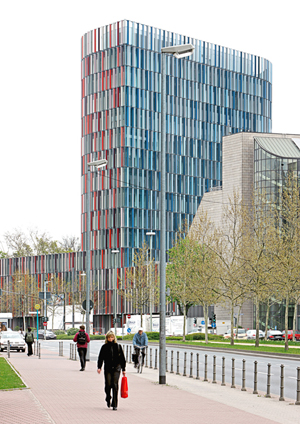 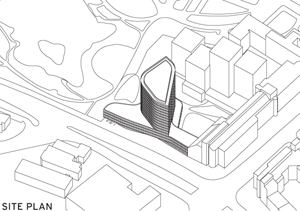 |
The skin includes colorful automated flaps that open, depending on conditions, to allow outdoor air to enter the facade cavity. Photo: © Jan Bitter |
The form was the outcome of an effort to preserve views and daylight for the occupants of the bank's cluster of existing buildings. At the same time, the designers hoped to reinforce the street edge and draw an adjacent botanical garden into the rear of the site.
This configuration, especially the tower's winglike shape, was also ideal for an unusual type of double-skin facade that takes advantage of the prevailing wind direction and should allow offices in the new KfW tower to rely on natural ventilation for several months of the year. "The urban concept and the ventilation strategy fit well together," says Tom Geister, Sauerbruch Hutton project architect.
The facade, along with several other coordinated features, including radiant slabs and geothermal heating and cooling, is expected to help the building meet an ambitious operating target of consuming no more than 27 kBtu per square foot of primary energy per year, if calculated in accordance with the U.S. standard ASHRAE 90.1 - about half the needs of a standard German office building. The goal was important to the client, since much of its lending activity supports energy-efficient housing and the development of sustainable technologies.
The KfW envelope system, which designers have dubbed a "pressure ring," consists of an encircling sawtooth-shaped cavity, 28 inches wide at its deepest point, that encloses automated blinds to block solar gain and control glare. The space is defined on the exterior by a skin made up of fixed, tempered-glass panels and colorful ventilation flaps, and on the interior by alternating operable and fixed argon-filled insulated glazing units (IGU) incorporating a low-E coating.
This double-wall assembly will extend the number of days each year that natural ventilation is practical, maximizing air quality, but not at the expense of energy conservation, according to Stuttgart-based Thomas Auer, managing director of Transsolar KlimaEngineering, the project's energy consultant. In high-rise buildings with operable windows, pressure differences on the windward and leeward faces can produce too much cross ventilation, causing unwanted heat loss, he explains. But at KfW, the pressure ring should keep the cross ventilation and associated heating loss in check.
The building has a roof-mounted weather station that monitors wind direction and speed, among other factors, and controls the ventilation flaps in the facade's outer shell.
Â
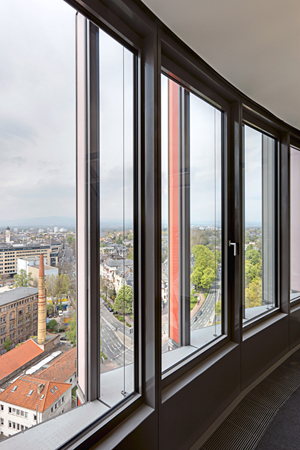 |
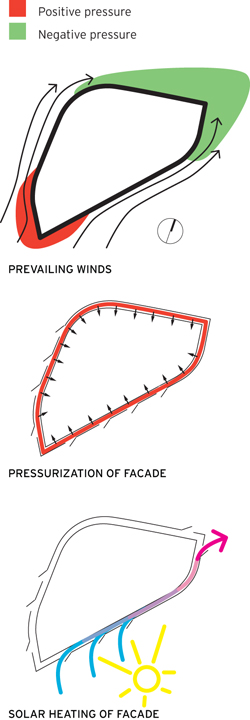 |
Above: The inner face of the KfW building's double-wall facade includes occupant-controlled windows. Right: The tower's airfoil shape and encircling cavity make the most of prevailing winds for natural ventilation. The cavity also provides protection from solar gain. Below: Fresh air supplied to the offices is vented through the corridors and then to the building core. Photos: © Jan Bitter |
|
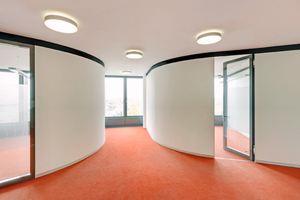 |
Â
Depending on conditions, the building management system (BMS) opens or closes flaps to introduce fresh air and create a zone of consistent pressure surrounding the curtain wall's inner skin while simultaneously producing a slight pressure differential between the cavity and the building's interior. This air is then drawn into offices through floor vents near the perimeter, or through the occupant-controlled windows. It is subsequently exhausted naturally to the negatively pressurized corridor, and ultimately through the building core.
Auer expects that the building will operate in this mode - with the mechanical systems for heating and cooling the offices off - during much of the spring and fall. During the winter and summer, the offices will be supplied with fresh outdoor air through a duct buried underneath a below-grade parking garage. It will carry the air from an intake louver located at the site's edge near the botanical garden and temper it with the constant temperature of the earth before delivering it to the work areas from a plenum below their raised floors. In winter, the air will be further warmed by a recovery system that captures heat from exhaust air and from the data center. And during the summer, radiant ceilings will absorb heat.









